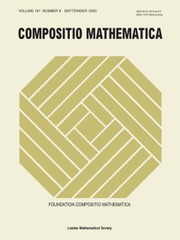No CrossRef data available.
Article contents
Mirror symmetry for log Calabi–Yau surfaces II
Published online by Cambridge University Press: 22 October 2025
Abstract
We show that the ring of regular functions of every smooth affine log Calabi–Yau surface with maximal boundary has a vector space basis parametrized by its set of integer tropical points and a  $\mathbb {C}$-algebra structure with structure coefficients given by the geometric construction of Keel and Yu [The Frobenius structure theorem for affine log Calabi–Yau varieties containing a torus, Ann. Math. 198 (2023), 419–536]. To prove this result, we first give a canonical compactification of the mirror family associated with a pair
$\mathbb {C}$-algebra structure with structure coefficients given by the geometric construction of Keel and Yu [The Frobenius structure theorem for affine log Calabi–Yau varieties containing a torus, Ann. Math. 198 (2023), 419–536]. To prove this result, we first give a canonical compactification of the mirror family associated with a pair  $(Y,D)$ constructed by Gross, Hacking and Keel [Mirror symmetry for log Calabi–Yau surfaces I, Publ. Math. Inst. Hautes Ètudes Sci. 122 (2015), 65168] where
$(Y,D)$ constructed by Gross, Hacking and Keel [Mirror symmetry for log Calabi–Yau surfaces I, Publ. Math. Inst. Hautes Ètudes Sci. 122 (2015), 65168] where  $Y$ is a smooth projective rational surface,
$Y$ is a smooth projective rational surface,  $D$ is an anti-canonical cycle of rational curves, and
$D$ is an anti-canonical cycle of rational curves, and  $Y\setminus D$ is the minimal resolution of an affine surface with, at worst, du Val singularities. Then, we compute periods for the compactified family using techniques from Ruddat and Siebert [Period integrals from wall structures via tropical cycles, canonical oordinates in mirror symmetry and analyticity of toric degenerations, Publ. Math. Inst. Hautes Ètudes Sci. 132 (2020), 1–82] and use this to give a modular interpretation of the compactified mirror family.
$Y\setminus D$ is the minimal resolution of an affine surface with, at worst, du Val singularities. Then, we compute periods for the compactified family using techniques from Ruddat and Siebert [Period integrals from wall structures via tropical cycles, canonical oordinates in mirror symmetry and analyticity of toric degenerations, Publ. Math. Inst. Hautes Ètudes Sci. 132 (2020), 1–82] and use this to give a modular interpretation of the compactified mirror family.
Keywords
MSC classification
Information
- Type
- Research Article
- Information
- Copyright
- © The Author(s), 2025. The publishing rights in this article are licensed to Foundation Compositio Mathematica under an exclusive licence


